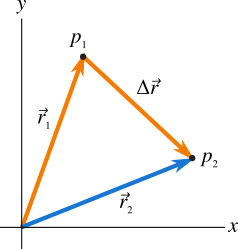In two or three dimensional situations the motion is not along a straight line were we need the velocity vector. The velocity vector is the rate of change of position vector. In two or three dimensional motion the motion is no longer in a straight line, and in that case we determine the position of an object with position vectors instead of displacement you did in velocity case in straight line motion.
Let's go ahead and illustrate this with an example. Consider an object which moves from a point \({{p}_{1}}\) to another point \({{p}_{2}}\) in two dimensional motion (xy-plane) as shown in Figure 4. In two or three dimensional motion the position is determined by the position vector.

Let the position vector of point \({{p}_{1}}\) be \({\vec{r}_{1}}\) and that of \({{p}_{2}}\) be \({\vec{r}_{2}}\). Now the net displacement in the direction of motion is , \[\Delta \vec r = {{\vec{r}}_{2}}-{{\vec{r}}_{1}}\]
Suppose the object's initial time at point \({{p}_{1}}\) is \({{t}_{1}}\) and at \({{p}_{2}}\) is \({{t}_{2}}\). So, the total time during the motion between the points is \(\Delta t={{t}_{2}}-{{t}_{1}}\). The velocity is the total displacement divided by the time taken during the displacement. Therefore the average velocity in vector form is,
\[\vec v_\text{av}=\frac{{{\vec{r}}_{2}}-{{\vec{r}}_{1}}}{{{t}_{2}}-{{t}_{1}}}=\frac{{\Delta \vec r}}{\Delta t} \tag{1} \label{1}\]
The subscript indicates that the velocity is average velocity. When \(\Delta t\) approaches zero the point \({{p}_{1}}\) moves closer and closer to the point \({{p}_{2}}\). Can you say the point \({{p}_{2}}\) moves closer and closer to the point \({{p}_{1}}\)?
In this case \(\Delta t\) approaches zero means that both \({{t}_{1}}\) and \({{t}_{2}}\) are almost equal, so we can also say that the point \({{p}_{2}}\) moves closer and closer to the point \({{p}_{1}}\) and vice versa. The instantaneous velocity in vector form in the limit that \(\Delta t\) approaches zero is given as,
\[{{\vec{v}}_{\text{ins}}}=\vec{v}=\frac{d\vec{r}}{dt} \tag{2} \label{2}\]
The subscript "ins" is for the instantaneous velocity but we generally ignore this subscript and think the velocity as instantaneous velocity without that subscript. We also call the instantaneous velocity in vector form velocity vector. Note that if we simply say velocity vector, we are talking about the instantaneous velocity vector not the average velocity vector. The above expression shows that the velocity vector at a particular instant is the instantaneous velocity vector.
In a three dimensional coordinate system know that \(\vec r = x\hat i + y \hat j + z \hat k\), and the velocity vector is
\[\vec v = \frac{d\vec r}{dt} = \frac{dx}{dt} \hat i + \frac{dy}{dt} \hat j + \frac{dz}{dt} \hat z \]
which is \(\vec v = \vec v_x + \vec v_y + \vec v_z\) where \(\vec v_x = dx/dt \hat i\), \(\vec v_y = dy/dt \hat j\) and \(\vec v_z = dz/dt \hat k\) are the components of the velocity vector whose magnitude is \(v = \sqrt{v_x^2 + v_y^2 + v_z^2}\). In a two coordinate system (in xy plane), \(v = \sqrt{v_x^2 + v_y^2}\).





